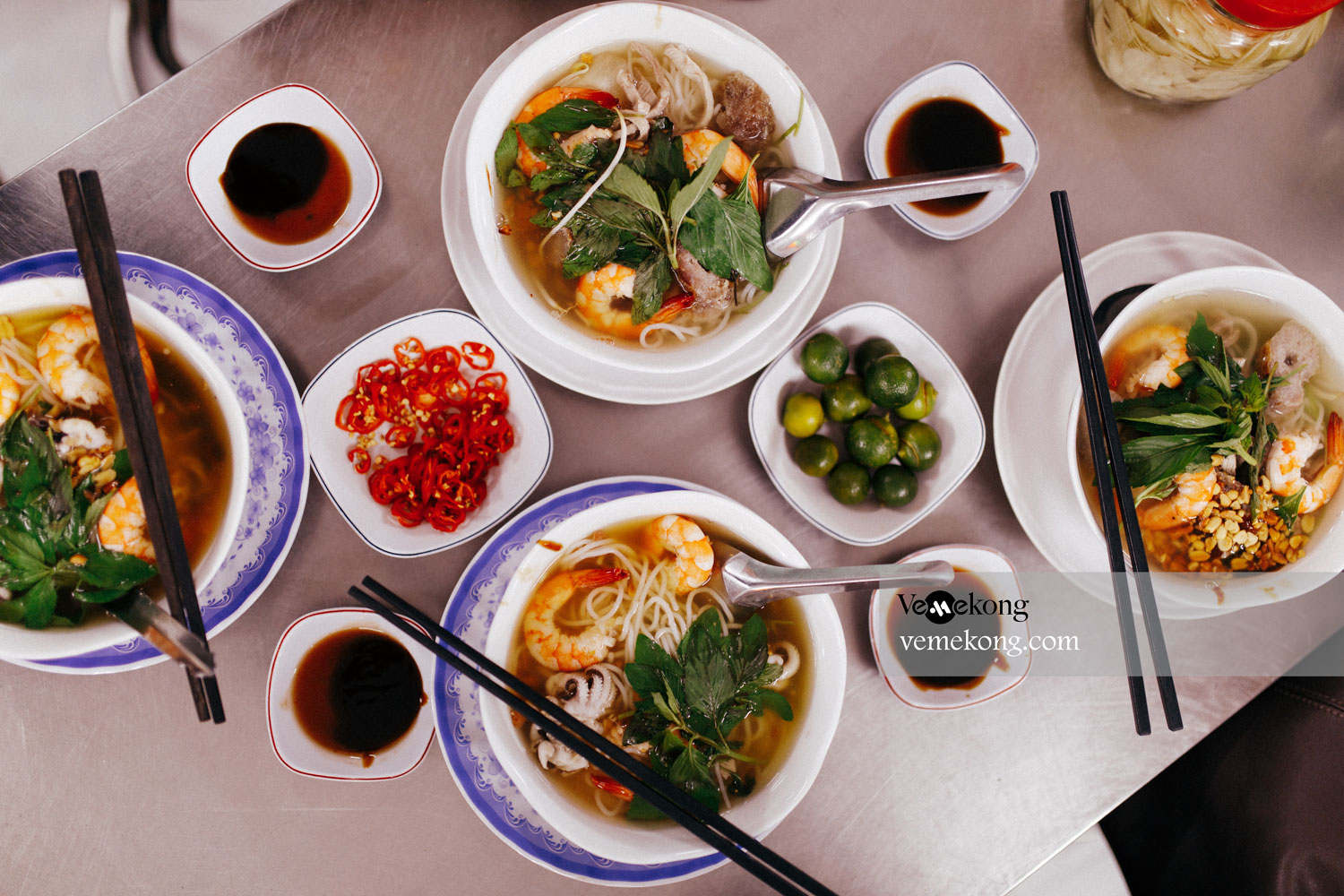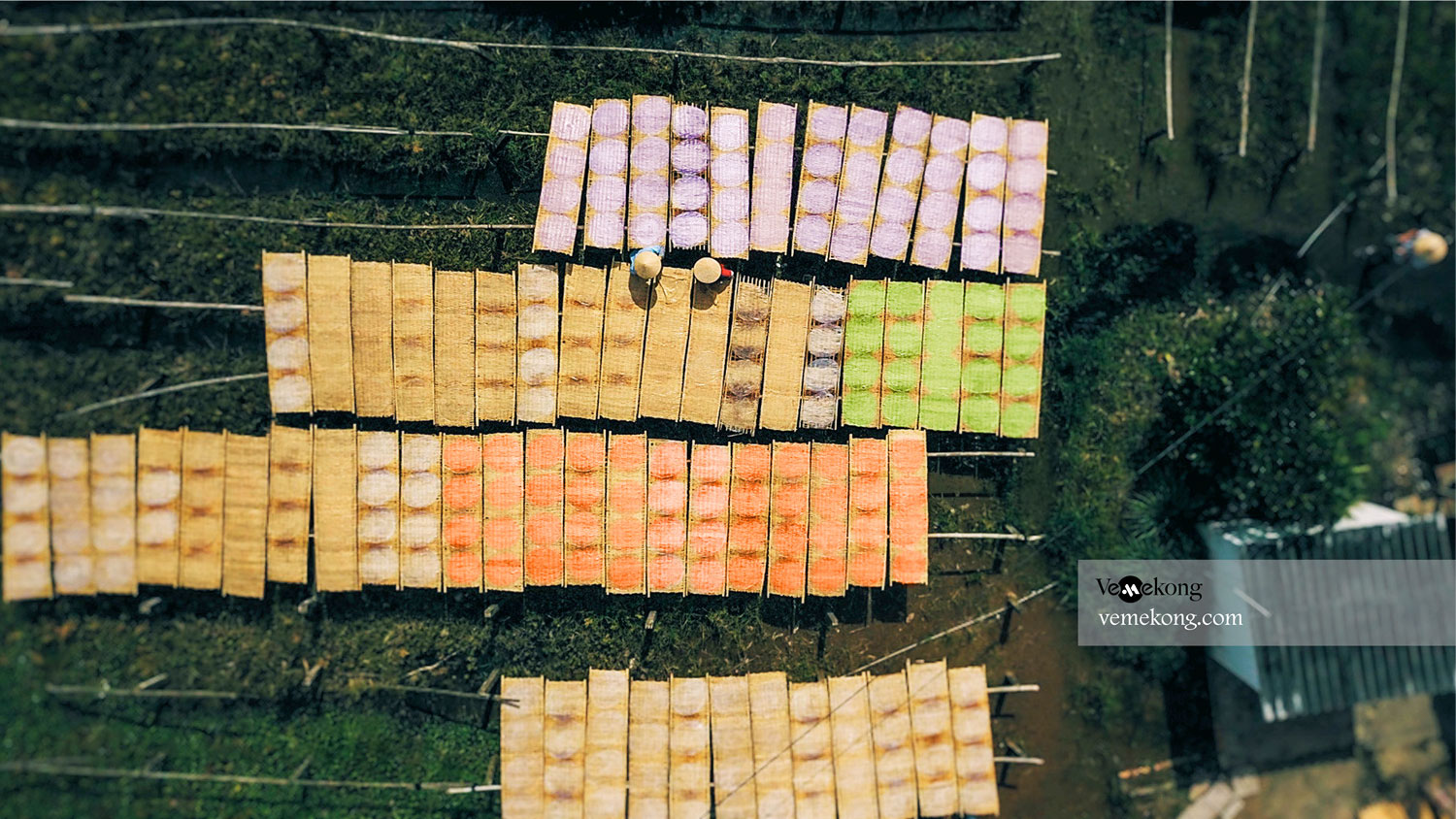Khmer-style Bun Goi Da Soup is a specialty that is not very familiar to tourists when coming to the Mekong Delta. According to local people, the dish comes from spring rolls. Travelling to Can Tho City, visitors will enjoy the unique taste of Bun Goi Da Soup.
By Thomas Vietnam at vemekong.com | All Best Foods & Restaurants in Can Tho
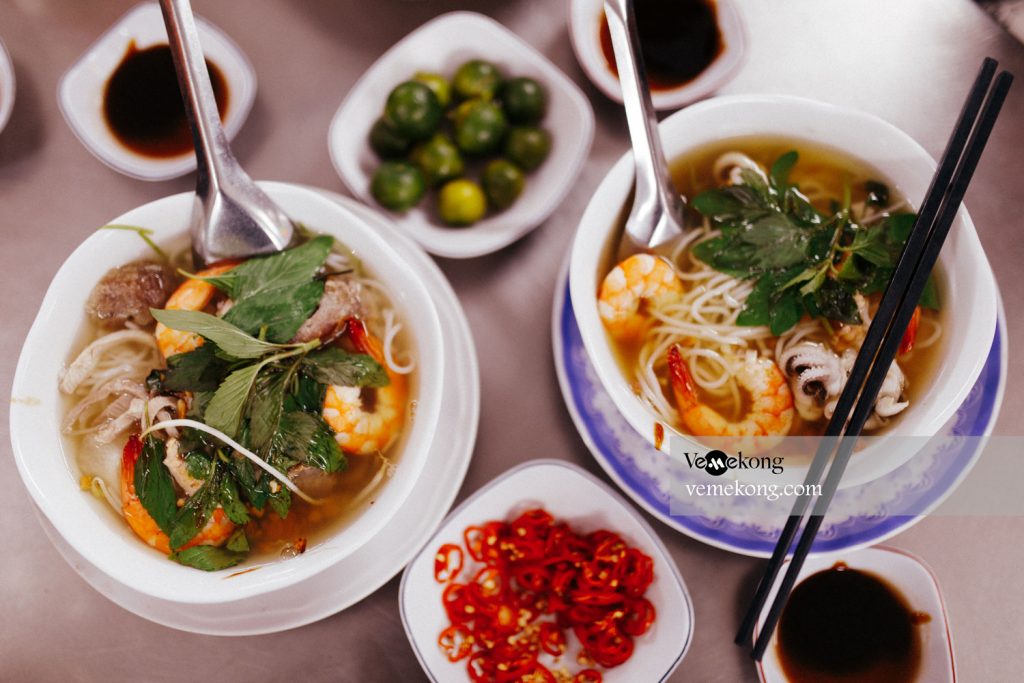
1. Better to Know as a Food Lover
Find them: Ninh Kieu District, Can Tho city.
Best time: Dusk-Dawn
Don’t miss: Khmer-style Bun Goi Da Soup
Local’s pick: Folk Cake Festival
Tourist’s pick: Chanh Map Bun Goi Da Soup restaurant
Blog: https://vemekong.com/khmer-style-bun-goi-da-soup-can-tho-soc-trang-food/
Facts: The local people enjoy the dish by “Và” (Gathering in one place) like eating rice. Due to the pronunciation of the word “và” to “dà”, from there, khmer-style bun goi da soup was born.
2. Better to Know Khmer-style bun goi da soup
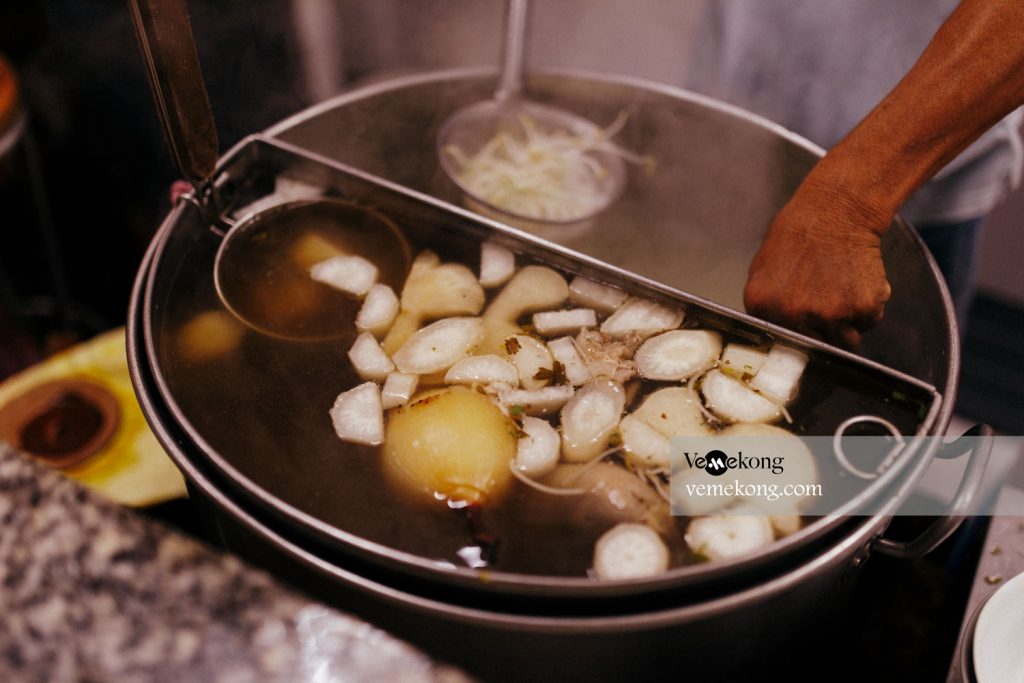
Going to the Mekong Delta, when you ask about the origin of the dish, you will hear the sentence: “My Xuyen co bun goi da, dung qua se thay dam da que huong”, referring to the famous dish in My Xuyen region, Soc Trang province. However, this dish is popular in many big cities in the Mekong Delta. This bun goi da soup dish is derived from a fresh spring roll dish.
3. Khmer-style bun goi da soup in Can Tho
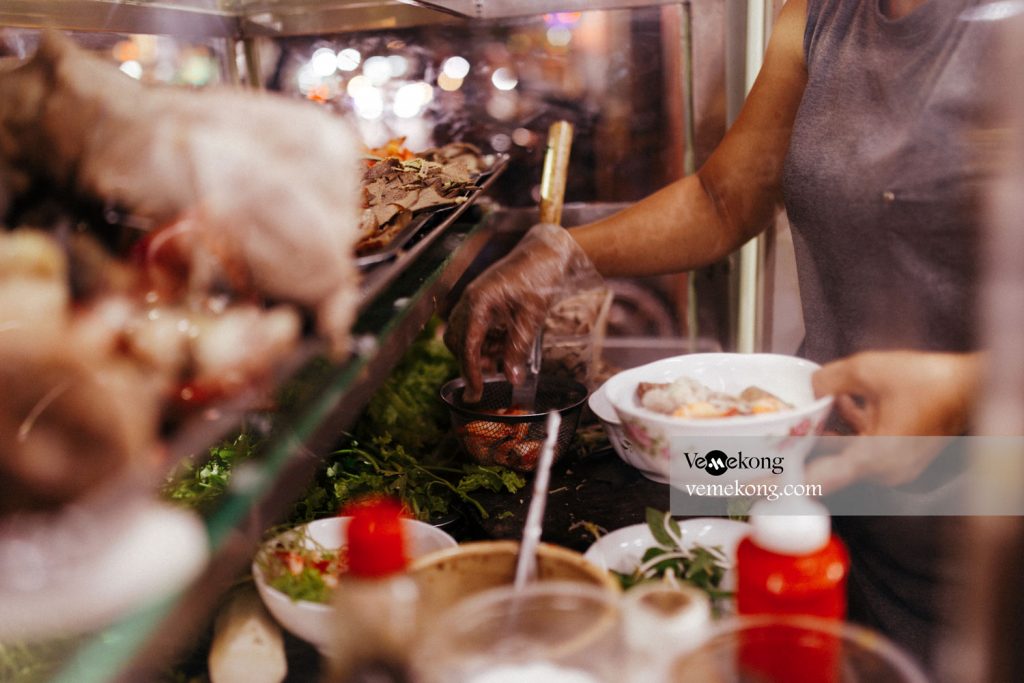
The dish tastes quite similar to vermicelli. In the past, this was a dry noodle dish. When serving, the chef brings out a bowl of vermicelli with a cup of broth. After that, many creative places directly poured the broth into the bowl. The water has a sour taste of tamarind and a characteristic smell of soy sauce. This is the highlight that makes the dish more recognizable.
Bun Goi Da soup with white vermicelli noodles, red peeled shrimp lying on top. Many places also add a little grated coconut or duck eggs to make it more flavorful.
Eaten together with Bun Goi Da soup are familiar vegetables such as bean sprouts, banana cabbage and a few cinnamon stalks. Peanuts are added in moderation, making the dish more fat. When serving to guests, restaurants often bring out a bowl of soy sauce to dip the meat. Do not forget to squeeze the kumquat (kumquat), add chili to eat better.
4. How to Make Khmer-style bun goi da soup
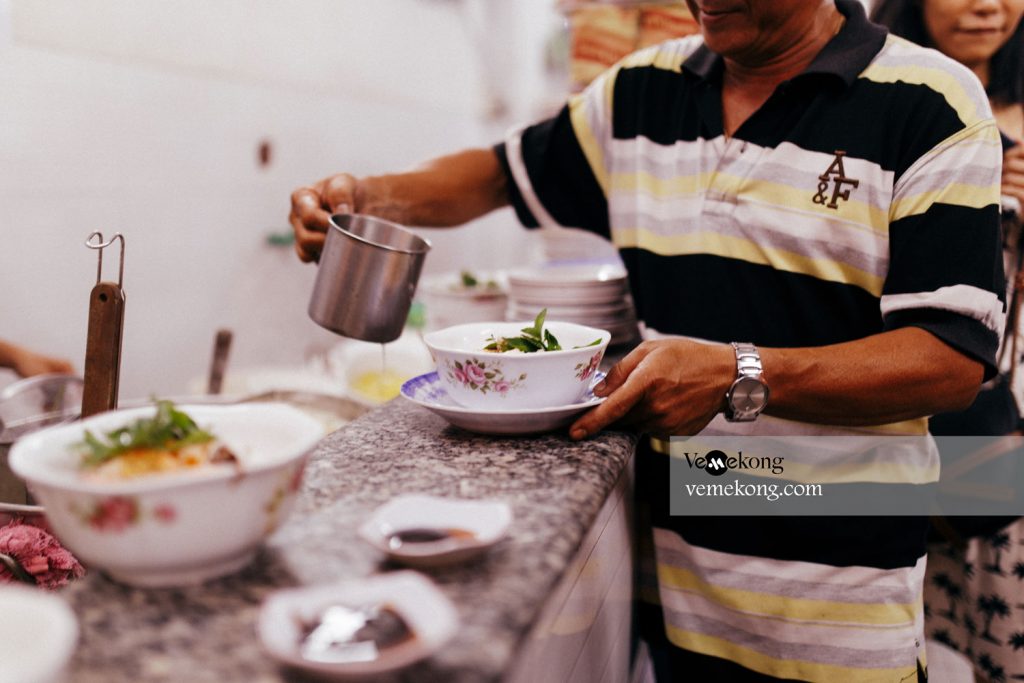
Ingredients to make bun goi da soup
Lean pork 1 kg
Tubular bone 700 gr
Shrimp 500 gr
Sliced ginger 15 gr
Purple onion 15 gr
Green onions 5 gr
(chopped)
Onion 100 gr
(Cut in half)
Pho sauce 2 tablespoons
2 tablespoons soy sauce
Tamarind 10 gr
Vermicelli 1 kg
Vegetables served with 1 little
1 serving ingredients
(Fried garlic / fried onions / crushed golden roasted peanuts)
How to choose and buy fresh ingredients
How to choose to buy fresh and quality pork
You should choose to buy pork with a bright pink color, no strange smell, clear white fat, and should not choose meat that is pale and has a bad smell.
You can press on the meat with your hands, if you observe that the meat is elastic right away, without leaving any dents, the meat is dry and not sticky, it means that this is a delicious piece of meat.
Delicious pork meat, the meat fibers must be even, firm and not oozing or viscous.
When buying meat, you should ask the seller to cut the meat along the grain and should not choose meat with small white wrappers alternating between the fibers because the piece of meat may have been infected with cysts, when you eat it, it will be adversely affected to health.
How to choose to buy delicious fresh shrimp

You should choose the ones that are still alive, the body is slightly curved, firm, flexible, the shell is glossy and smooth, the shrimp head must still be attached to the body, the shrimp legs must be attached to the body and intact.
You can try stretching the shrimp under the light, observing the shrimp joints, the narrower the joint, the fresher the shrimp!
You should not choose the ones that have melted, the body is bent into a round shape, the joints are wide, the legs turn black, when pressing on the shell and moving the hand a few times, it feels like there is a grit under the finger.
How to cook Bun Goi Da soup
Step 1. Prepare and boil pork
Cook about 1.2 liters of water until toothpick bubbles emerge, then add ginger, 15g crushed shallot, 1/2 teaspoon salt, 1 teaspoon sugar, 1 tablespoon vinegar, mix well. Wait for the water to boil for the pork to boil.
How to prepare clean, odorless pork
Purchased pork should not be left for too long in a plastic bag, so use salt to rub the whole piece of meat, rub and squeeze, and then rinse with water thoroughly.
Boiling with ginger helps eliminate odors effectively, but be careful not to add too much, to avoid creating a bitter taste for the broth.
While boiling, you should remove the foam often to remove the smell of meat!
When the meat is cooked, take it out and put it in a bowl of cold water, wait for it to cool, then wash it thoroughly and cut it into small pieces.
Tip: You can use chopsticks to skewer the meat, find it easy to skewer, the white meat is not red, it is cooked.
Pork bones use hot water about 60 degrees Celsius, add 1 tablespoon salt, 1 tablespoon vinegar, soak for 5 minutes. Rinse with clean water.
Put another pot of water on the stove, about 3 liters of water, add onions, 1 tablespoon salt, 1 tablespoon sugar and put the whole bones in the stew for 4 hours.
Step 2. Preliminary processing and boiling shrimp
When you buy shrimp, you break off the head, then peel off the shell.
Next, use the tip of the knife to make an incision on the back of the shrimp, to expose the shrimp only.
Then gently use a bamboo toothpick to remove the shrimp thread.
Note:
You should only slit just enough to see only shrimp meat is still stuck together.
You can wash the shrimp with a little diluted salt water to make sure its fishy smell will disappear. Then put the shrimp in the previous pot of broth, boil for about 2 minutes, then take it out.
Step 3. Prepare other ingredients
Wash raw vegetables and drain. Cut chives into short pieces about 5cm. Cucumber, cut into small pieces.
Other vegetables cut into 2 or 3 to taste.
Add a little boiling water to 10g of tamarind, gently blend to make tamarind juice. Use a sieve to get the water.
Step 4. Make soy sauce
Put 2 tablespoons of non-aromatic cooking oil in the pot with 10g of minced purple onion. Take 2 tablespoons of soy sauce, 1 tablespoon of sugar, 2 tablespoons of pho, use a spoon to stir until dissolved.
Add 1 tbsp of satay, 60ml of water, stir well until thickened. Seasoning to taste again.
Step 5. Cooking broth
Re-filter the previous part of shrimp, meat, and bone broth, remove the residue, keep the water clear.
Add 1 tablespoon chicken seasoning powder, 2 tablespoons soy sauce, 1 tablespoon satay oil, tamarind juice, and stir well.
Note:
Because the dish comes with soy sauce, when seasoning the broth, it should be a bit pale, avoid seasoning when adding soy sauce to become salty.
Do not add too much tamarind, making the water sour and losing the characteristic taste of the dish.
Step 6. Complete
Take a sufficient amount of vermicelli, pour directly with boiling broth, put in a bowl and add all ingredients on top. Add broth, some satay, roasted peanuts, fried onions and enjoy!
Step 7. Finished product
The delicious Bun goi Da soup combines with the rich sweetness of the meaty broth, the bone and the sweetness of the shrimp, served with the same delicious blend!
Tips when making Bun Goi Da soup
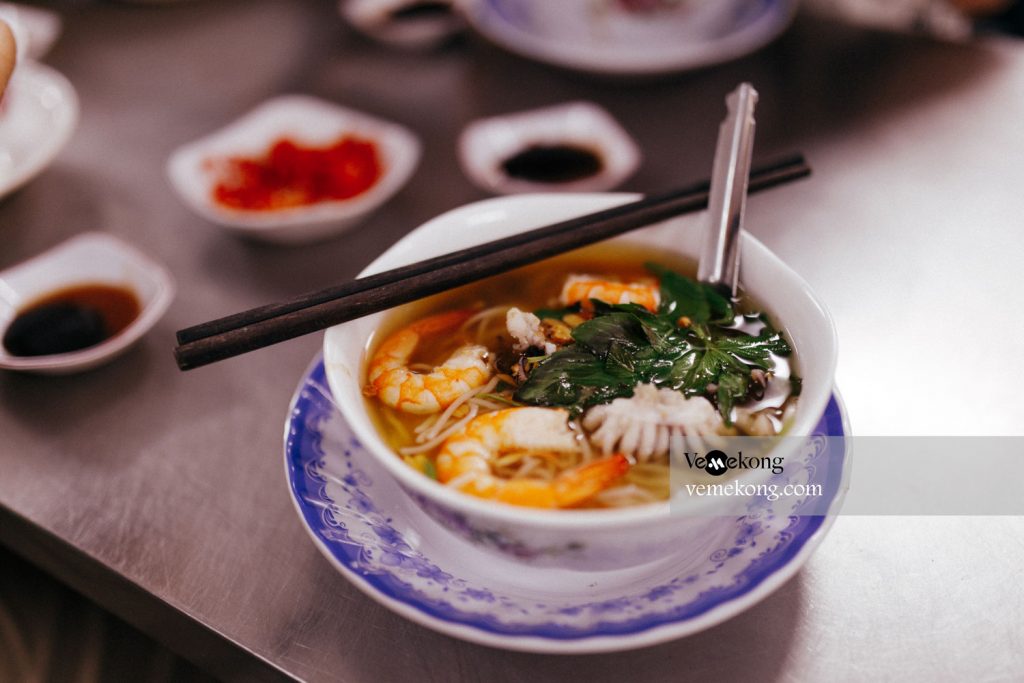
In order to keep the deliciousness of the noodles, it is best to eat where the noodles are.
Because you have to boil the vermicelli directly in the broth, you can divide the broth into a smaller pot, to avoid spoiling the whole pot.
Soy sauce produced with different brands has different flavors, you should re-season according to your family’s taste to make the broth perfect!
5. Pro tips:
Here are our tips for easing your mind (and stomach) around food-handling environments that you may not be used to.
Make sure the food is freshly cooked. If you’re eating hot street food, it’s always safest (not to mention more delicious) to eat food you can see being cooked to order.
Look for lines and busy stalls. Busy street food stalls are an indicator of popularity, and their high turnover rate means the food is never sitting out for hours and developing dreaded bacteria. Yes, long lines can be discouraging when you’re hungry after a full day of exploring, but it’s not worth the risk of grabbing precooked food from the empty spot next door.
Eat when the locals are eating. The last and most important element here is when to eat. You’re likely already on a weird eating schedule while you’re traveling, but it’s important to try and adjust to the eating times of where you are. A bowl of pho might be lunch for Americans, but it’s breakfast for the Vietnamese. This ensures that you’re eating freshly cooked food and that you can find the best and most popular places to eat.
If you can’t drink the water, then you can’t eat the salad. Most people get so hung up on not drinking the water or skipping ice in drinks that they don’t think about all of the other ways in which water is used in food service. Fruits and vegetables tend to be washed with tap water in most places, rather than the filtered water that locals drink—or sometimes it’s not washed at all. If you’re really craving some produce, try fruits you can peel or cooked veggies.
Trust your gut. If you’re unsure about the food or the way that it’s being prepared, then keep moving. Eating street food all over the world doesn’t make you an expert. Every stall and every country are different, and sometimes the rules can be harder to follow. When something doesn’t look, smell, or feel right, don’t eat it! Trust your judgment. Chances are that there’s another spot close by that’s making something more delicious.
Must-Eat Foods & Restaurants in Can Tho: Co Ut’s Cong cake, Ut Dzach Fine Rice Vermicelli, Thanh Van Grilled Pork Sausage, Crab Noodle Soup At Floating Market, Scorched Rice with Caramelized Fish Sauce, 7-Toi’s Duck Meat Pancake, Banh Mi Thuy, Banana Blossom Salad, Fried Spring Rolls, Fresh Spring Rolls, Fetal duck egg (balut), Honeycomb Cake, Mini Sticky Rice Cake, Cassava Silkworm Cake, Grilled Banana Wrapped in Sticky Rice, Khmer-style Bun Goi Da Soup, Egg Coffee, Con Son Grilled Snakehead Fish, Bun Mam – Fermented Fish Noodle Soup, Lau Mam – Fermented Fish Hotpot, Grilled Snails with Pepper, Magenta Sticky Rice Cake, Duck cooked with Fermented Tofu, Rice Noodle Pizza, Vegetarian Noodle Soup, Snails Stuffed With Pork…
Must-Eat Foods & Restaurants in Chau Doc: Chau Doc Fish Noodle Soup, Sugar Palm Fruit, Basa Fish Hot Pot, Mam (Fermented fish), Phu Huong Beef Noodle Soup, Broken Rice with Pork Chop, Long Xuyen Broken Rice, Nui Cam Pancake, O Thum’s Chicken Grilled with Lime Leaves, Stir-fried Shrimp with Sesbania Flower, Sweet & Sour Soup with Siamese Mud Carp Soup & Sesbania Flower, Caramelized & Braised Catfish, Grilled Rice-field Rat with Salt and Chili…
Must-Eat Foods & Restaurants in Soc Trang: Pia Cake, Cong Cake (Banh Cong), Bun Nuoc Leo Soc Trang’s Noodle Soup, Soc Trang’s Bun Goi Da Soup, Duck Noodle Soup with black Pepper, Curry Noodle Soup, Grilled Beef on Tile, Khmer-style Tube Cake, Khmer-style Mung Bean Cake (Banh In), Dried Radish (Xa Bau), Stir-Fried Noodles with Seafood (Mi Sua), Soc Trang’s Green Rice Flakes…
Must-Eat Foods & Restaurants in Ben Tre: Phu Le Rice Wine, Ben Tre’s Coconut Candy, Flat Banana, Coconut Rice, Snail Pancake, Sea Snail with Coconut Milk, Coconut Worm, Young Coconut Salad with Shrimp & Pork, Son Doc Puff Rice Paper…
Must-Eat Foods & Restaurants in Cai Be: Puffed Rice Cake…
Must-Eat Foods & Restaurants in Vinh Long: Elephant Ear Fish (fried giant gourami)…
Must-Eat Foods & Restaurants in My Tho: Fried Sticky Rice, Snakehead Fish Rice Porridge, Hu Tieu My Tho (Noodle Soup), Coconut Banana Cake…
Must-Eat Foods & Restaurants in Tra Vinh: Macapuno Coconut, Bun Nuoc Leo Tra Vinh’s Noodle Soup, Tra Cuon’s Sticky Rice Cake…
Must-Eat Foods & Restaurants in Sadec: Sa Dec Noodle Soup, Sadec Crab Hotpot, Lai Vung Spring Rolls, Sa Giang Shrimp Puff Pastry, Lai Vung Tangerine…
Must-Eat Foods & Restaurants in Bac Lieu: Spicy Beef Noodle Soup, Bac Lieu’s Three-striped Crab, White Radish Pies, Bac Lieu Thick Noodles & Creamy Coconut Milk, Bon Bon Pickles…
Must-Eat Foods & Restaurants in Ca Mau: Banh tam ga cay (Silkworm rice cake with curried chicken), Grilled Vop clams with salt and pepper, Grilled Mudskipper Fish, Stone Crab Roast With Salt, Young Bee Salad, Nam Can’s Crab, U Minh Forest’s Honey, U Minh’s Fermented Fish Hotpot…
Must-Eat Foods & Restaurants in Hau Giang: Cau Duc Pineapple, Cai Tac’s Pork Organs Porridge, Hau Giang’s Bronze Featherback Fish Cake…
Must-Eat Foods & Restaurants in Ha Tien: Herring Fish Salad, Spider crab cake soup, Ken Noodle soup, Xoi Xiem (Siamese sticky rice), Steamed Noodle soup, Ha Tien Oyster porridge…
Must-Eat Foods & Restaurants in Rach Gia: Stir Noodle Soup, Kien Giang Fish Noodle Soup…
Must-Eat Foods & Restaurants in Con Dao: Bang nut jam, Vu Nang Snail, Roasted Pork Bread (Banh Mi), Coconut Ice Cream…
Must-Eat Foods & Restaurants in Phu Quoc: Phu Quoc Sim Wine, Phu Quoc Pepper, Phu Quoc fish sauce…
Hopefully, the above tips will help you to come up with a great plan for your adventure in Mekong River Delta, Vietnam. Have a safe trip!
“Sleep less, travel more, respect more” – Thomas Vietnam – Local travel expert.
Thank you
